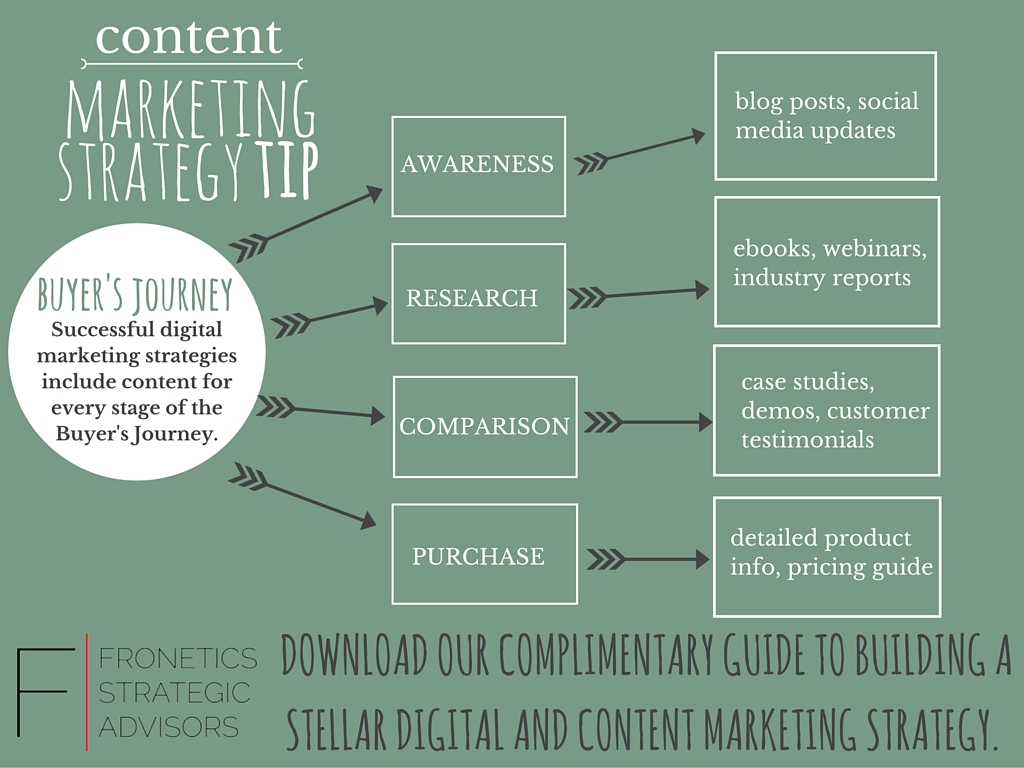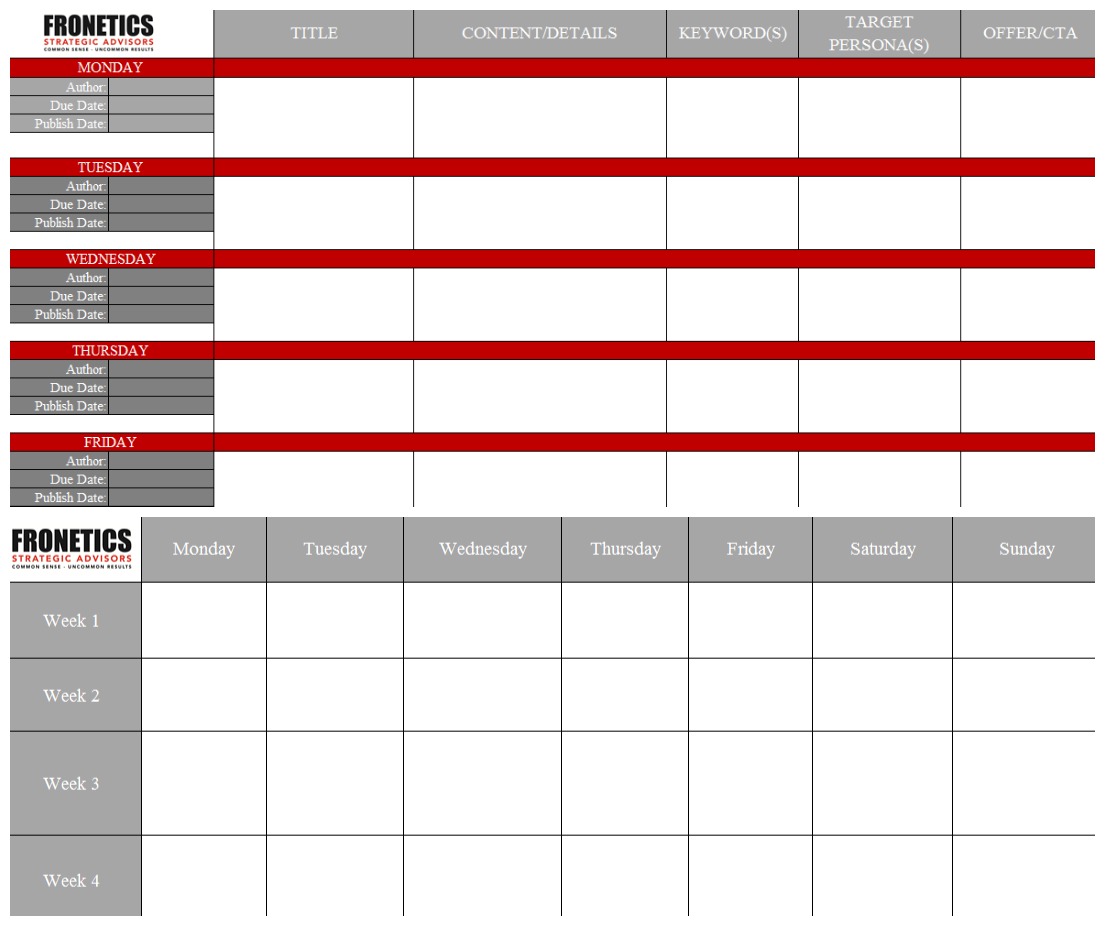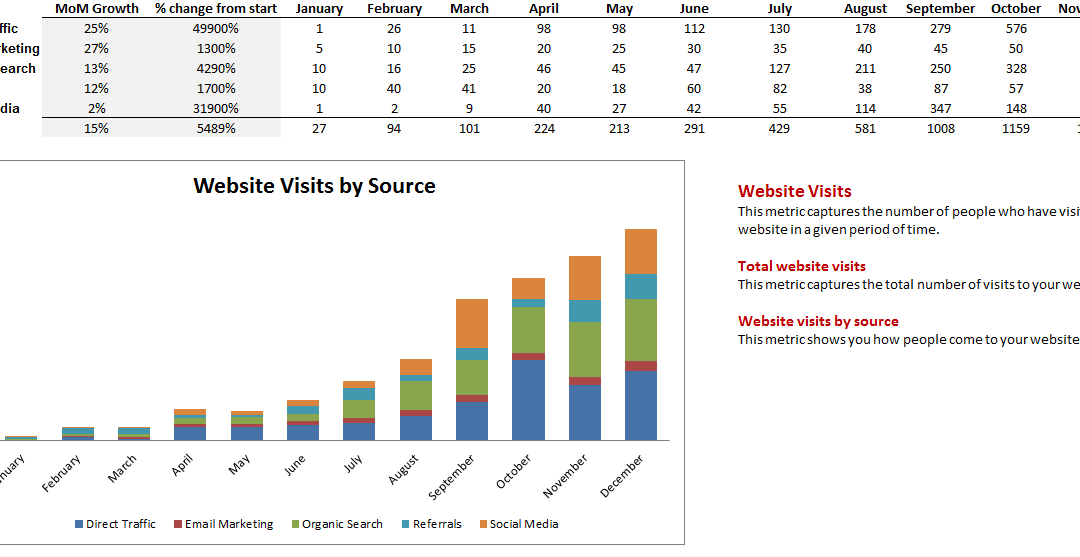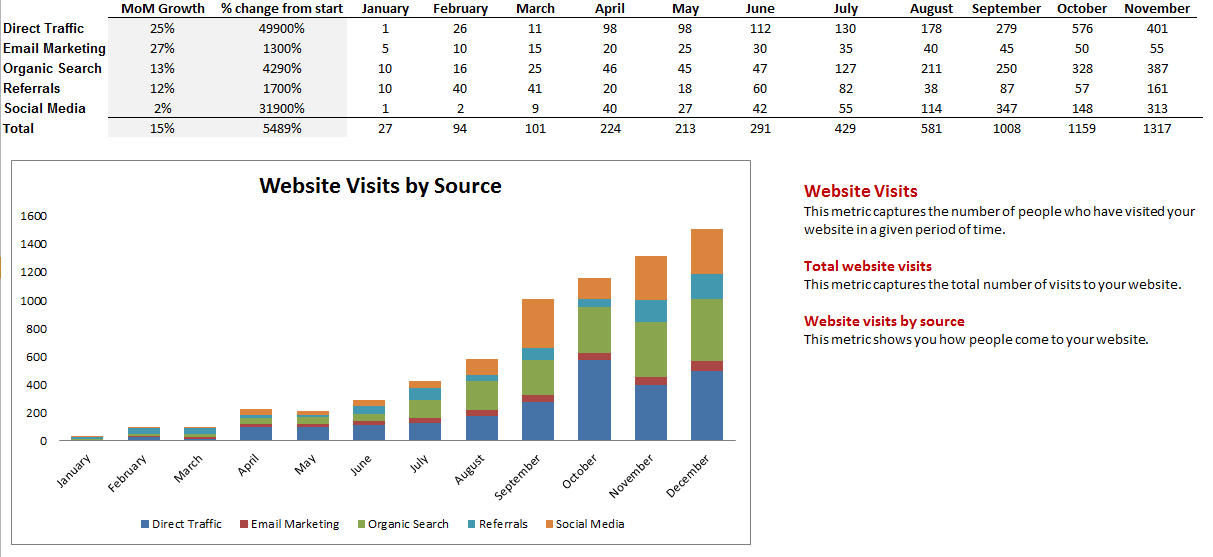![How to create an effective content strategy [Template]](https://fronetics.com/wp-content/uploads/2024/10/content-strategy-1024x675.jpg)
by Fronetics | Oct 26, 2015 | Blog, Content Marketing, Marketing, Strategy
With 3 out of 4 marketers across the globe prioritizing content marketing, producing unique content to attract and convert website visitors can be tough. From social media to blog posts to ebooks and webinars, buyers are accessing your content through a myriad of channels. The amount and frequency of content to create can be dizzying. Fortunately, by starting with a solid strategy you can assure your content flows freely and your marketing content stands out.
One key element of any successful content strategy is mapping your buyer’s journey. Considering the path of purchase of current customers can give you valuable insight into the stages that a lead goes through before becoming a customer. Typically, buyers follow a track that looks something like this: awareness, research, consideration, and purchase. Knowing your buyer’s journey can inform your decisions about what kinds of content will resonate with your prospects and which channels of distribution will be most successful connecting them to your content.

Of course, just mapping out your Buyer’s Journey won’t lead to content marketing success. It’s certainly important, but it should be one component in your overall strategy. Start building a comprehensive content strategy that includes goal setting, developing buyer personas, setting keywords, and brainstorming content topics by using our free Content Strategy Template. You’ll be well on your way to creating great content and attracting even better leads.

You may also like:
Fronetics Strategic Advisors is a leading management consulting firm. Our firm works with companies to identify and execute strategies for growth and value creation.
We advise and work with companies on their most critical issues and opportunities: strategy, marketing, organization, talent acquisition, performance management, and M&A support.
![Why you need an editorial calendar for your blog [Free template]](https://fronetics.com/wp-content/uploads/2024/10/editorial-calendar-template-1080x675.jpg)
by Fronetics | Feb 16, 2015 | Blog, Content Marketing, Marketing, Strategy
An editorial calendar is an invaluable tool; it will drive success.
When it comes to blogging, you may know what outcomes your company is looking to achieve, but do you have a specific plan to get there? We know post and pray isn’t an effective strategy.
Enter the editorial calendar. The use of an editorial calendar gives structure to your blogging efforts. Think of it as both a commitment to your potential customers and built-in accountability for your overall strategy.
The editorial calendar is a dynamic, internal document that will help your team determine what activities you’ll focus on (and when they’ll be completed) in order to connect and engage potential customers with your blog content. Presented in a calendar-like format, an editorial calendar makes it easy to visualize your marketing strategy, ensuring consistently scheduled blog posts and a diversity of topics. Beyond scheduling blog posts, the use of an editorial calendar keeps other essential considerations front of mind. Including related information, such as keyword assignments, target persona(s), and associated promotions or calls to action, will make your editorial calendar an indispensable guide to your blogging success.
We’ve created an editorial calendar template to guide your blogging efforts. Designed to keep you on track as you develop content that will attract and engage your prospects and customers, our template (it’s free) will help you map out your content in a strategic manner, maximize productivity, and keep you organized.


![Why you need an editorial calendar for your blog [Free template]](https://fronetics.com/wp-content/uploads/2024/10/editorial-calendar-template-1080x675.jpg)
by Fronetics | Feb 16, 2015 | Blog, Content Marketing, Marketing, Strategy
An editorial calendar is an invaluable tool; it will drive success.
When it comes to blogging, you may know what outcomes your company is looking to achieve, but do you have a specific plan to get there? We know post and pray isn’t an effective strategy.
Enter the editorial calendar. The use of an editorial calendar gives structure to your blogging efforts. Think of it as both a commitment to your potential customers and built-in accountability for your overall strategy.
The editorial calendar is a dynamic, internal document that will help your team determine what activities you’ll focus on (and when they’ll be completed) in order to connect and engage potential customers with your blog content. Presented in a calendar-like format, an editorial calendar makes it easy to visualize your marketing strategy, ensuring consistently scheduled blog posts and a diversity of topics. Beyond scheduling blog posts, the use of an editorial calendar keeps other essential considerations front of mind. Including related information, such as keyword assignments, target persona(s), and associated promotions or calls to action, will make your editorial calendar an indispensable guide to your blogging success.
We’ve created an editorial calendar template to guide your blogging efforts. Designed to keep you on track as you develop content that will attract and engage your prospects and customers, our template (it’s free) will help you map out your content in a strategic manner, maximize productivity, and keep you organized.



by Fronetics | Sep 10, 2014 | Blog, Data/Analytics, Marketing, Strategy
Metrics matter. Metrics allow you to measure success, drive strategy, and demonstrate the ROI of your marketing efforts. Conversions are one of the most important metrics to monitor.
Why conversion rates matter
What is a conversion? A conversion means action. It means that someone took some action that entered them into your funnel or moved them further down your funnel. Examples of conversions are: downloading a white paper, filling out a form, requesting information, opening an email, and becoming a customer.
By monitoring and tracking conversions you can determine what marketing efforts are paying off. Additionally, by monitoring and tracking conversions you can identify which efforts need to be re-evaluated or even discontinued. In short, conversion rates can help you measure your ROI.
Why conversion rates don’t matter
Conversion rates are not the Holy Grail of metrics. Your website should be a magnet. It should attract and engage prospective customers and current customers. Your website should serve to educate and to establish your business as an industry leader. Eighty to 90 percent of prospects are not ready to make a purchase when they first engage with your company. Conversion rates don’t capture the amount of time people spend on your website, learning, exploring, and getting to know your business. Conversion rates also do not capture the amount of time current customers spend on your website – valuing your company as a resource.
While conversion rates are an important metric to measure, remember that they are not the end all be all.
Tracking conversion rates
We created a template that you can download and use to track conversion rates and other critical metrics. While the template captures visitor-to-lead and lead-to-customer conversion rates, you can easily modify the template to include additional conversion rates that are useful to your business.



by Fronetics | Sep 2, 2014 | Blog, Content Marketing, Data/Analytics, Marketing, Supply Chain

To grow your B2B business you need to take a comprehensive data driven approach to marketing. Metrics enable you to measure success, drive strategy, and demonstrate the ROI of your marketing efforts.
What metrics should you track?
Given that your objective is to attract, acquire, and retain customers, the most effective metrics to track are those where the unit of focus is the prospect, lead, or customer. These include the following:
Visits
Visits capture the number of visitors to your company’s website in a given period of time. In addition to tracking the total number of visits, it is also important to track visits by source. That is, how visitors come to your website. Sources typically include direct traffic, organic search, referrals, social media, and email marketing.
Reach
Reach is the number of people who can be reached through your marketing channels (e.g. LinkedIn, Twitter, and Facebook). This metric is a good indicator of how well the content you are publishing attracts new people to your network, and how well the content engages people within your network. In addition to tracking your company’s total reach (the total number of people you can reach across all channels), you should also track reach by channel.
Leads
Leads are one of the strongest indicators of ROI. By tracking leads by source, you can identify where your marketing efforts are most effective, areas where you can improve, and areas you could eliminate from your strategy.
Customers
Customers are also a strong indicator of ROI. Like leads, customers should be tracked by source.
Conversion rates
Conversion rates measure the percentage of people who are moving from one marketing stage to the next. An increase in your conversion rates implies an improvement in the quality of your content and/or traffic. You should track the visit-to-lead conversion rate (How many of your website visitors are becoming new leads?) as well as the lead-to-customer conversion rate (Are you generating sales-ready leads?).
Ranking
Ranking matters. The top listing in Google’s organic search results receives 33 percent of the traffic compared to 18 percent in the second position. Two metrics you can track are your domain authority and your marketing grade.
Domain authority is a score ranging from 1 to 100 that represents how well a website will perform in a search engine ranking. The lower the score – the less likely it will be found. Marketing grade is a holistic measure of a site’s online presence as measured by HubSpot’s Marketing Grader on a scale of 0-100. A higher score is better.
How to track metrics for success
Having an established database to capture your marketing metrics is critical to success. We created a template that you can download and use to track your metrics, measure success, and drive strategy. One of the great features about this template is that it generates graphs that can be used in your reports and presentations.


![How to create an effective content strategy [Template]](https://fronetics.com/wp-content/uploads/2024/10/content-strategy-1024x675.jpg)



![Why you need an editorial calendar for your blog [Free template]](https://fronetics.com/wp-content/uploads/2024/10/editorial-calendar-template-1080x675.jpg)






